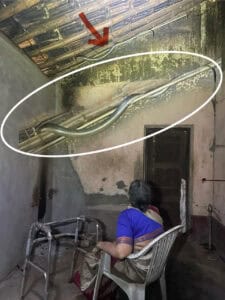As part of its work in conservation and research, the Madras Crocodile Bank Trust has established four field stations in India dedicated to the study of reptiles. One of them is the Agumbe Rainforest Research Station (ARRS) in the Western Ghats – the first in the world to study King Cobra ecology and behaviour using radio telemetry. The institution’s Program Coordinator Rithan Bopanna shared the captivating tale of a recent incident involving not one, not two, but three King Cobras. We hope that you will enjoy reading it as much as we did.
Associate Editor, Madras Musings
One day, we received a call from a community member who said that there were two massive King Cobras inside a home. Knowing that the King Cobra combat season had just begun, we rushed to the site. There, the ajji (old lady) of the household told us that she’d seen two snakes mating inside. We soon realized that it wasn’t an act of mating, but one of combat – two males were fighting for the same female. Classic King Cobra drama!
The house was an old structure, made of mud walls. When we stepped inside, we spotted just one snake, coiled up. Naturally, we wondered where the other male was. The house was a maze of dark corners and full of hiding spots a snake would love, so we knew that he could be anywhere. We searched for a while and were on the verge of giving up when Abhi our tracker gave a shout – he had found the female! We rushed to the room he was in and saw that she was there, all right – coiled up right beneath a huge male! The combat had taken place because the female had accidentally wandered into the house.

Ajji looking up at the victor of the combat.
During the breeding season, female King Cobras release pheromones which males in search of a mate detect and follow. When two males converge on the same trail, they often end up in combat – an intense display of strength where one male attempts to subdue the other. The winner gets to mate, and the loser retreats. The mating male and the female remain together for about 25 to 35 days after which the female sets off to build a nest – a unique behaviour. King cobras are the only snake species in India known to construct nests, with a clutch size ranging from 18 to 40 eggs.
At ARRS, we’ve spent years understanding these patterns. From mid-March to the end of April – the peak of the king cobra breeding season – we get a sharp rise in rescue calls. But instead of rushing to relocate the snakes, we try something different. We stay, observe, speak to the families, and wait. It’s not the easiest route, but it’s the most meaningful. Because the moment we relocate a breeding pair, we risk interrupting a cycle.
Coming back to our story, we realized that we had to make a decision which required the landlord’s approval. The authority was none other than ajji. We told her about the breeding habits of King Cobras, and after an hour of discussion, she looked at us and said, “Let’s not catch the snakes. Let them do their thing. We will manage.”
That moment felt like a huge win for our work.
The next morning, I woke up early and raced to the house. When I got there, I was shocked to see only the female. I quickly called our Field Director Ajay to let him know, and he asked me to search thoroughly and not miss any possible hiding places. We knew the snake had a way out, but there were still many places to hide. I did not want to end up face-to-face with that massive male, so I searched every corner – even places you wouldn’t quite expect to find a snake, but where they almost always end up.
After half an hour, I found him coiled up tight in the attic. Honestly, I wasn’t sure whether to laugh or cry. When I broke the news to the family, they were quite calm. He’s hanging out in the attic? No problem. When the sun came up, the female slipped out of the house leaving the male behind. The family spent another night with a snake beneath their roof and I couldn’t help but think that the whole thing was quite wild – literally! I was back at the house the next day, early in the morning. The male started moving when it became warmer, and he too finally left the house in the evening.
Altogether, the family had spent three days and two nights under the same roof with King Cobras! It took a lot of courage, patience and conversation, but we did it – we helped ensure that the breeding season was respected and, more importantly, made certain that the family was safe.
This incident stands out as a true example of human-snake co-existence. Thanks to ajji and her open-mindedness, these three kings were able to live their natural lives amidst human habitation. ARRS has done well in engaging members of the local community who, like ajji, have come to respect the snakes and recognise that this is their habitat too. This story isn’t an exception – it’s part of a growing culture of human-snake coexistence, made possible through awareness, patience, and trust.

Agumbe Rainforest Research Station. Picture courtesy: Wikipedia.
ARRS is more than just a research station, it’s a place where science, community, and conservation meet. Whether you’re a volunteer, intern, researcher, or nature enthusiast, you’re welcome to participate. Come walk the rainforest trails, listen to the cicadas, and maybe, just maybe, witness a story like ajji’s for yourself. You never know what kind of wildlife story you’ll be a part of.